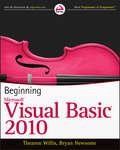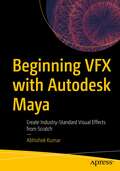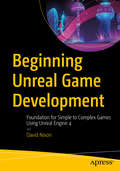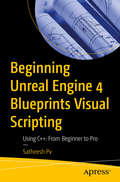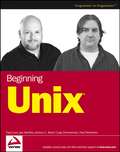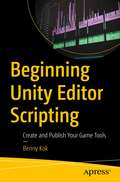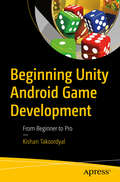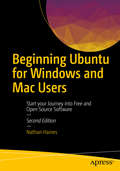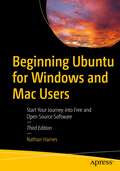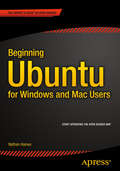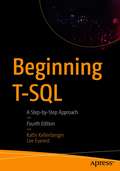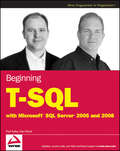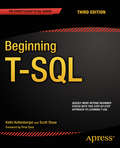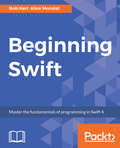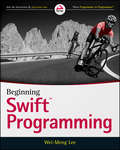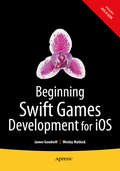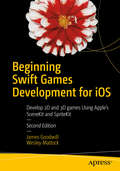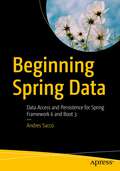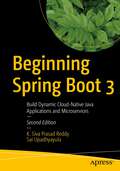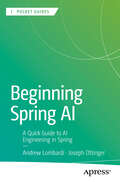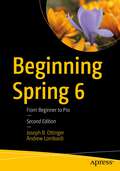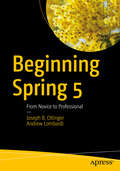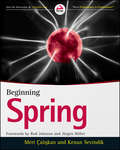- Table View
- List View
Beginning Visual Basic 2010
by Thearon Willis Bryan NewsomeVisual Basic 2010 offers a great deal of functionality in both tools and language. No one book could ever cover Visual Basic 2010 in its entirety--you would need a library of books. What this book aims to do is to get you started as quickly and easily as possible. It shows you the roadmap, so to speak, of what there is and where to go. Once we've taught you the basics of creating working applications (creating the windows and controls, how your code should handle unexpected events, what object-oriented programming is, how to use it in your applications, and so on) we'll show you some of the areas you might want to try your hand at next.
Beginning VFX with Autodesk Maya: Create Industry-Standard Visual Effects from Scratch
by Abhishek KumarDive into the nuances of visual effects (VFX) design, from planning to execution, using Autodesk Maya. This book introduces the methods and techniques required for your first foray into 3D FX generation from scratch. You will start with the fundamentals of visual effects, including a history of VFX, tools and techniques for creating believable visual effects, and popular tools used in the industry. Next, you are introduced to Autodesk Maya and its various components that make it a favorite among professionals. You will learn how to create rigid body collisions and simulate realistic particles such as dust, fire, water, and more.This book also presents strategies for creating a vortex, rain, hair, fluids, and other soft body simulations and also demonstrates nature element simulations for computer-generated production. At the end of the book, there is a capstone project to make your own visual effects scene in a practical way. After going through this book, you will be able to start building computer-generated visual effects from your imagination through to production.What You Will LearnUnderstand the basic physics behind effect creationCreate 3D visual effects scenes from scratchKnow the details of dynamic simulation in the computer generation space using various functionalities available in Autodesk MayaWho This Book Is ForBeginning-level users; students from the field of visual effects design, 3D modeling, and simulation; game designers; those creating computer graphics; FX artists and aspirants looking for a career in the field of 3D
Beginning Unreal Game Development: Foundation for Simple to Complex Games Using Unreal Engine 4
by David NixonGet started creating video games using Unreal Engine 4 (UE4) and learning the fundamentals of game development. Through hands-on, step-by-step tutorials, you will learn to design engaging environments and a build solid foundation for more complex games. Discover how to utilize the 3D game design software behind the development of immensely popular games for PC, console, and mobile. Beginning Unreal Game Development steers you through the fundamentals of game development with UE4 to design environments that both engage the player and are aesthetically pleasing. Author David Nixon shows you how to script logic, define behaviors, store data, and create characters. You will learn to create user interfaces, such as menus, load screens, and head-up displays (HUDs), and manipulate audio to add music, sound effects, and dialogue to your game. The book covers level editors, actor types, blueprints, character creation and control, and much more. Throughout the book, you’ll put theory into practice and create an actual game using a series of step-by-step tutorials. With a clear, step-by-step approach, Beginning Unreal Game Development builds up your knowledge of Unreal Engine 4 so you can start creating and deploying your own 3D video games in no time. What You Will Learn Learn the fundamentals of game designUnderstand how to use Unreal Engine 4Design amazing levels for your characters to play inScript logic to control the behavior of the world you create Who This Book Is ForThis book is for beginners with no prior game design or programming experience. It is also intended for video game enthusiasts who are brand-new to the world of game development and want to learn how to design a game from scratch using UE4.
Beginning Unreal Engine 4 Blueprints Visual Scripting: Using C++: From Beginner to Pro
by Satheesh PvDiscover how Unreal Engine 4 allows you to create exciting games using C++ and Blueprints. This book starts with installing, launching, and examining the details of Unreal Engine. Next, you will learn about Blueprints and C++ and how to leverage them. The following chapters talk in detail about gameplay, basic physics, and ray-casting for game development in Unreal Engine. Furthermore, you’ll create material, meshes, and textures. The last chapter brings all the concepts together by building a demo game. By the end of the book, you’ll be equipped with the know-how and techniques needed to develop and deploy your very own game in Unreal Engine. What You Will Learn Discover Blueprints and how to apply them in Unreal Engine 4 Get started with C++ programming in Unreal Engine 4 Apply the concepts of physics and ray-casting Work with the Gameplay Framework Who This Book Is For Beginners interested in learning Blueprints visual scripting and C++ for programming games in Unreal Engine 4 would find this book useful.
Beginning Unix
by Paul Love Jeremy C. Reed Craig Zimmerman Paul Weinstein Joe MerlinoCovering all aspects of the Unix operating system and assuming no prior knowledge of Unix, this book begins with the fundamentals and works from the ground up to some of the more advanced programming techniques The authors provide a wealth of real-world experience with the Unix operating system, delivering actual examples while showing some of the common misconceptions and errors that new users make Special emphasis is placed on the Apple Mac OS X environment as well as Linux, Solaris, and migrating from Windows to Unix A unique conversion section of the book details specific advice and instructions for transitioning Mac OS X, Windows, and Linux users
Beginning Unity Editor Scripting: Create and Publish Your Game Tools
by Benny KokLearn about editor scripting in Unity, including different possible methods of editor customization to fit your custom game workflow or even to create assets that could be published on the Asset Store to earn a passive income. The knowledge of editor scripting, although rarely covered in books, gives a game developer insight into how things work in Unity under the hood, which you can leverage to create custom tools that empower your unique game idea. This book starts with the very basics of editor scripting in Unity, such as using built-in attributes to customize your component’s editor and creating custom editors and windows with IMGUI and UI Toolkit. Next, we move to a general use case example by creating an object spawner EditorTool for the scene view. Later, we dive straight to in-depth stats and detailed case studies of two Unity assets: ProArray and Rhythm Game Starter. Here you’ll get more context on how editor scripting is used in published assets. You will also learn how to set up a better workflow for editor scripting, asset publishing, maintenance, and iterative updates. You will leverage the power of modern web technology to build a documentation site with GitBook and DocFX. Finally, you will see some tips and tricks for automating asset versioning and changelogs. What You Will Learn Get started with Editor scripting in Unity Work with advanced editor topics such as custom EditorWindows and EditorTool Structure your C# code with namespaces and asmdef Use IMGUI and UI Toolkit for creating editor GUIs Master packaging and selling your own editor tools Set up a better workflow for asset publishing, maintenance, and iterative updates Who This Book Is For Readers who want to learn about editor scripting to improve their game-development process and create tools for themselves. Moderate experience with C# and a fundamental knowledge of Unity is expected.
Beginning Unity Android Game Development: From Beginner to Pro
by Kishan TakoordyalMaster the art of programming games for Android using the Unity3D game engine. This book will help you understand basic concepts of game development in Unity. By the end of Beginning Unity Android Game Development, you will have the knowledge to confidently build an Android game. The book starts by explaining simple programming concepts to make beginners comfortable with the jargon. You will then learn to navigate around the Unity interface and use basic tools (hand, move, rotate, scale, and rect). You will also be acquainted with the creation of basic 3D objects in the game while understanding the purpose of several of Unity’s windows. In the last chapters, you will learn to create a simple game for Android using the concepts studied in the previous chapters. Scripts will be written to handle the behaviors of the player and enemies as well as to handle other aspects of the game. The author shares tips along the way to help improve in-game performance, such as switching to the universal rendering pipeline when targeting mobile platforms. At the end of the book, you will have a solid knowledge in making basic Android games that can be upgraded later to make more complex games.What You Will LearnExplore basic Unity and C# programming concepts and scripting for Android gamesNavigate around the Unity interface and use its basic toolsMake the most of popular components and features of UnityWrite an Android game with optimizations Who This Book Is For Absolute beginners learning to program games for the Android platform using Unity3D. Basic knowledge of programming would be beneficial for the reader but is not required.
Beginning Ubuntu for Windows and Mac Users: Start your Journey into Free and Open Source Software
by Nathan HainesBeginning Ubuntu for Windows and Mac Users is your comprehensive guide to using Ubuntu. You already know how to use a computer running Windows or OS X, but learning a new operating system can feel daunting. If you've been afraid to try Ubuntu because you don't know where to start, this book will show you how to get the most out of Ubuntu for work, home, and play. You'll be introduced to a wide selection of software and settings that will make your computer ready to work for you. Ubuntu makes your computing life easy. Ubuntu's Software Updater keeps all of your software secure and up-to-date. Browsing the Internet becomes faster and safer. Creating documents and sharing with others is built right in. Enjoying your music and movie libraries helps you unwind. In addition to a tour of Ubuntu's modern and easy-to-use interface, you'll also learn how to: * Understand the advantages of Ubuntu and its variants--Kubuntu, Xubuntu, and more * Install Ubuntu on its own or alongside your computer's existing operating system * Search Ubuntu's catalog of thousands of applications--all ready to install with a single click * Work with files and disks that were created with Windows and OS X * Run simple, interesting tasks and games using the command line * Customize Ubuntu in powerful ways and get work done with virtual machines Ubuntu is the world's third most popular operating system and powers desktop and laptop computers, servers, private and public clouds, phones and tablets, and embedded devices. There's never been a better time to install Ubuntu and move to an open source way of life. Get started with Beginning Ubuntu for Windows and Mac Users today!
Beginning Ubuntu for Windows and Mac Users: Start Your Journey into Free and Open Source Software
by Nathan HainesCompletely updated for this exciting third edition, Beginning Ubuntu for Windows and Mac Users will help you start your journey into Free and Open Source Software with Ubuntu 22.04.1 LTS with GNOME 42.This book is a friendly guide to installing and running Ubuntu for people who are already efficient and happy with Windows or macOS computers. It teachers new Ubuntu users how to navigate their new operating system, perform basic tasks and suggests specific applications to handle routine tasks.You'll start by installing Ubuntu and its related “flavors” (Kubuntu, Ubuntu MATE, etc.) and how they differ from each other. The rest of the book breaks down application suggestions by broad categories to fill in gaps in the default installed system, or suggest fun things that the reader might not have even thought of. The command line is handled after you are comfortable with the system and ready for something interesting but different. It's presented as a powerful interface that can either be approached casually as a unique method of interacting with the computer, as an occasional tool to use, or as a fun way to get in touch with an early way of using a computer.A brief look at “power user” topics gives advice on managing running processes, installing alternate desktop software, using virtual desktops and creating virtual machines. It’s a great way to round off the book with starting points for advanced topics that are more specialty topics. An appendix describes the Ubuntu release schedule, naming, and timing.The book is designed to function as a “travel guide” to Ubuntu, offering both a scenic tour through some of the great software in Ubuntu in a practical “here’s what you can do with this” style as well as a comprehensive reference guide that the reader can return to over and over to learn how to accomplish specific tasks. What You'll LearnUnderstand the advantages of Ubuntu and its variants—Kubuntu and XubuntuInstall Ubuntu on its own or alongside your computer's existing operating systemSearch Ubuntu's catalog of thousands of applicationsWork with files and disks that were created with Windows and OS XRun simple, interesting tasks and games using the command lineCustomize Ubuntu in powerful ways and get work done with virtual machinesWho This Book Is ForBeginning to intermediate computer users with Windows 7 or OS X or later experience
Beginning Ubuntu for Windows and Mac Users: Start Your Journey Into Free And Open Source Software
by Nathan HainesBeginning Ubuntu for Windows and Mac Users is your comprehensive guide to using Ubuntu. You already know how to use a computer running Windows or OS X, but learning a new operating system can feel daunting. If you've been afraid to try Ubuntu because you don't know where to start, this book will show you how to get the most out of Ubuntu for work, home, and play. You'll be introduced to a wide selection of software and settings that will make your computer ready to work for you. Ubuntu makes your computing life easy. Ubuntu's Software Updater keeps all of your software secure and up-to-date. Browsing the Internet becomes faster and safer. Creating documents and sharing with others is built right in. Enjoying your music and movie libraries helps you unwind. In addition to a tour of Ubuntu's modern and easy-to-use interface, you'll also learn how to: * Understand the advantages of Ubuntu and its variants--Kubuntu, Xubuntu, and more * Install Ubuntu on its own or alongside your computer's existing operating system * Search Ubuntu's catalog of thousands of applications--all ready to install with a single click * Work with files and disks that were created with Windows and OS X * Run simple, interesting tasks and games using the command line * Customize Ubuntu in powerful ways and get work done with virtual machines Ubuntu is the world's third most popular operating system and powers desktop and laptop computers, servers, private and public clouds, phones and tablets, and embedded devices. There's never been a better time to install Ubuntu and move to an open source way of life. Get started with Beginning Ubuntu for Windows and Mac Users today!
Beginning Teaching with Digital Technology
by Joanne BlanninTeachers are now expected to use technology to enhance students’ learning, but what does this mean in the classroom and how can you apply it effectively to subject teaching? This book, for pre-service and qualified teachers, offers you a guide for using technology in primary and secondary schools, including how to decide which technology resource to use, safeguarding and ethical considerations and computer coding in the classroom. Further guidance is provided on using technology across the learning areas of literacy, mathematics, STEM and the arts. Key features include: · Classroom scenarios which tackle common challenges faced by teachers and how to resolve them · Examples of best practice technology use in early childhood settings, primary and secondary classrooms · A future-proofed approach focusing on theory-informed best practice in an ever-changing world of devices and software Essential reading for pre-service teacher education students in both primary and secondary education courses on undergraduate and postgraduate routes into teaching and for qualified teachers looking to deepen their professional knowledge. Joanne Blannin is Senior Lecturer in Digital Transformations at Monash University.
Beginning Teaching with Digital Technology
by Joanne BlanninTeachers are now expected to use technology to enhance students’ learning, but what does this mean in the classroom and how can you apply it effectively to subject teaching? This book, for pre-service and qualified teachers, offers you a guide for using technology in primary and secondary schools, including how to decide which technology resource to use, safeguarding and ethical considerations and computer coding in the classroom. Further guidance is provided on using technology across the learning areas of literacy, mathematics, STEM and the arts. Key features include: · Classroom scenarios which tackle common challenges faced by teachers and how to resolve them · Examples of best practice technology use in early childhood settings, primary and secondary classrooms · A future-proofed approach focusing on theory-informed best practice in an ever-changing world of devices and software Essential reading for pre-service teacher education students in both primary and secondary education courses on undergraduate and postgraduate routes into teaching and for qualified teachers looking to deepen their professional knowledge. Joanne Blannin is Senior Lecturer in Digital Transformations at Monash University.
Beginning T-SQL: A Step-by-Step Approach
by Kathi Kellenberger Lee EverestGet a performance-oriented introduction to the T-SQL language underlying the Microsoft SQL Server and Azure SQL database engines. This fourth edition is updated to include SQL Notebooks as well as up-to-date syntax and features for T-SQL on-premises and in the Azure cloud. Exercises and examples now include the WideWorldImporters database, the newest sample database from Microsoft for SQL Server. Also new in this edition is coverage of JSON from T-SQL, news about performance enhancements called Intelligent Query Processing, and an appendix on running SQL Server in a container on macOS or Linux. Beginning T-SQL starts you on the path to mastering T-SQL with an emphasis on best practices. Using the sound coding techniques taught in this book will lead to excellent performance in the queries that you write in your daily work. Important techniques such as windowing functions are covered to help you write fast-executing queries that solve real business problems.The book begins with an introduction to databases, normalization, and to setting up your learning environment. You will learn about the tools you need to use such as SQL Server Management Studio, Azure Data Studio, and SQL Notebooks. Each subsequent chapter teaches an aspect of T-SQL, building on the skills learned in previous chapters. Exercises in most chapters provide an opportunity for the hands-on practice that leads to true learning and distinguishes the competent professional. A stand-out feature in this book is that most chapters end with a Thinking About Performance section. These sections cover aspects of query performance relative to the content just presented, including the new Intelligent Query Processing features that make queries faster without changing code. They will help you avoid beginner mistakes by knowing about and thinking about performance from day 1.What You Will LearnInstall a sandboxed SQL Server instance for learningUnderstand how relational databases are designedCreate objects such as tables and stored proceduresQuery a SQL Server table Filter and order the results of a queryQuery and work with specialized data types such as XML and JSONApply modern features such as window functionsChoose correct techniques so that your queries perform wellWho This Book Is ForAnyone who wants to learn T-SQL from the beginning or improve their T-SQL skills; those who need T-SQL as an additional skill; and those who write queries such as application developers, database administrators, business intelligence developers, and data scientists. The book is also helpful for anyone who must retrieve data from a SQL Server database.
Beginning T-SQL with Microsoft SQL Server 2005 and 2008
by Paul Turley Dan WoodIf you've not programmed with Transact-SQL, this book is for you.It begins with an overview of SQL Server query operations and tools used with T-SQL, and covers both the 2005 and 2008 releases of SQL Server query tools and the query editor. The book then moves to show you how to design and build applications of increasing complexity. Other important tasks covered include full text indexing, optimizing query performance, and application design and security considerations. The companion website also provides all of the code examples from the book.
Beginning T-SQL
by Scott Shaw Kathi KellenbergerBeginning T-SQL is a performance-oriented introduction to the T-SQL language underlying the Microsoft SQL Server database engine. T-SQL is essential in writing SQL statements to get data into and out of a database. T-SQL is the foundation for business logic embedded in the database in the form of stored procedures and functions. Beginning T-SQL starts you on the path to mastering T-SQL, with an emphasis on best-practices and sound coding techniques leading to excellent performance. This new edition is updated to cover the essential features of T-SQL found in SQL Server 2014, 2012, and 2008. Beginning T-SQL begins with an introduction to databases, normalization, and to SQL Server Management Studio. Attention is given to Azure SQL Database and how to connect to remote databases in the cloud. Each subsequent chapter teaches an aspect of T-SQL, building on the skills learned in previous chapters. Exercises in most chapters provide an opportunity for the hands-on practice that leads to true learning and distinguishes the competent professional. Important techniques such as windowing functions are covered to help write fast executing queries that solve real business problems. A stand-out feature in this book is that most chapters end with a 'Thinking About Performance' section. These sections cover aspects of query performance relative to the content just presented. They'll help you avoid beginner mistakes by knowing about and thinking about performance from Day 1. Imparts best practices for writing T-SQLHelps you avoid common errorsShows how to write scalable code for good performance
Beginning Swift [Book]: Master the fundamentals of programming in Swift 4
by Robert Kerr Kåre MorstølMaster the fundamentals of programming in Swift 4Key Features Covers theory and practice in equal parts Teaches you how to correctly structure and architect software using Swift Uses real-world examples to connect the theory to a professional setting Imparts expertise in the core Swift standard libraryBook DescriptionTake your first foray into programming for Apple devices with Swift.Swift is fundamentally different from Objective-C, as it is a protocol-oriented language. While you can still write normal object-oriented code in Swift, it requires a new way of thinking to take advantage of its powerful features and a solid understanding of the basics to become productive.This course helps you develop client-side and server-side applications, as well as web services using Swift. We'll begin with exploring the fundamental Swift programming concepts, language structure, and the Swift programming syntax. Then, we'll learn to create original custom operators with Swift operators, branching, and loops.Moving on, we'll learn how to run application codes and compile errors. Having made progress with it, we'll see how Swift compares to other computer languages and how to transform your thinking. Then, master the usage of key language elements, such as strings and collections. Finally, grasp how Swift supports modern application development using advanced features, such as built-in Unicode support and higher-order functions.This is an introductory course to the Swift programming language with Xcode.After completing this course, students will be well-prepared to begin developing native end-user applications for iOS or macOS, or to develop server-side (back-end) application and web services using Swift on Linux.What you will learn Explore the fundamental Swift programming concepts, language structure, and the Swift programming syntax Learn how Swift compares to other computer languages and how to transform your thinking to leverage new concepts such as optionals and protocols Master how to use key language elements, such as strings and collections Grasp how Swift supports modern application development using advanced features, such as built-in Unicode support and higher-order functions.Who this book is forIf you are seeking fundamental Swift programming skills, in preparation for learning to develop native applications for iOS or macOS, this book is the best for you. You don’t need to have any prior Swift knowledge; however, object-oriented programming experience is desired.
Beginning Swift Programming
by Wei-Meng LeeEnter the Swift future of iOS and OS X programmingBeginning Swift Programming is your ideal starting point for creating Mac, iPhone, and iPad apps using Apple's new Swift programming language. Written by an experienced Apple developer and trainer, this comprehensive guide explains everything you need to know to jumpstart the creation of your app idea. Coverage includes data types, strings and characters, operators and functions, arrays and dictionaries, control flow, and looping, with expert guidance on classes, objects, class inheritance, closures, protocols, and generics. This succinct -- yet complete -- overview provides a detailed introduction to the core features of Swift.Apple developed Swift to address the limitations of Objective-C, and add features found in more complex languages like Python. The results is simpler, cleaner, more expressive code with automatic memory management, functional programming patterns, and more, including built-in features that make Swift apps faster, scalable, and more secure. This book explains it all, helping developers master Apple's new language.Become fluent with syntax that's easier to read and maintainUnderstand inferred types for cleaner, less mistake-prone codeLearn the key features that make Swift more expressive than Objective-CLearn the new optional types in Swift that make your code more resilientUnderstand the key design patterns in iOS and Mac OS programming using protocols and delegatesLearn how to use generics to create highly reusable codeLearn the new access controls mechanism in SwiftGet up to speed quickly to remain relevant and ahead of the curve.
Beginning Swift Games Development for iOS: Updated For Swift 3
by James Goodwill Wesley MatlockGame apps are one of the most popular categories in the Apple iTunes App Store. Well, the introduction of the new Swift programming language will make game development even more appealing and easier to existing and future iOS app developers. In response, James Goodwill, Wesley Matlock and Apress introduce you to this book, Beginning Swift Games Development for iOS. In this book, you'll learn the fundamental elements of the new Swift language as applied to game development for iOS. In part 1, you'll start with a basic 2D game idea and build the game throughout the book introducing each SpriteKit topic as we add new functionality to the game. By the end of the book, you'll have experience with all the important SpriteKit topics and have a fully functional game as a result. In part 2 of this book, you'll learn 3D game development using Apple's SceneKit framework and the Swift programming language. And, you'll follow the same pattern we used for part 1. After reading and using this book, you'll have the skills and the code to build your first 2D and then 3D game app that you can run on any iOS enabled device and perhaps sell in the Apple iTunes App Store. What you'll learn What is the Swift Programming Language How to apply it to iOS game development How to use SpriteKit with Swift How to use SceneKit with Swift How to build your first 2D game app using SpriteKit and Swift How to build 3D game from 2D using SceneKit and Swift Who this book is for This book is for iOS app developers new to Swift or for those thinking of doing iOS game app development for the very first time. Table of Contents Part I 1. Setting up your First Game Scene and Adding your First Sprite 2. Digging into the SpriteKit Scene 3. Physics and Collision Detection 4. Adding Scene Scrolling and Game Control 5. Actions and Animations 6. Adding Particle Effects to Your Game with Emitter Nodes 7. Points, Scoring and Sounds 8. Transitioning Between Scenes 9. Refactoring and Best Practices Part II 10. Creating Your First SceneKit Project 11. Building the Scene 12. Lighting, Camera and Materials in SceneKit 13. Animating SceneKit Models 14. Adding Hit Testing and Collision Detection 15. Using SpriteKit within a SceneKit Scene 16. Advanced Topics and Tips 17. Appendix A: The Swift Programming Language
Beginning Swift Games Development for iOS: Develop 2D and 3D games Using Apple's SceneKit and SpriteKit
by James Goodwill Wesley MatlockGame apps are one of the most popular categories in the Apple iTunes App Store. Well, the introduction of the new Swift programming language will make game development even more appealing and easier to existing and future iOS app developers. In response, James Goodwill, Wesley Matlock and Apress introduce you to this book, Beginning Swift Games Development for iOS. In this book, you'll learn the fundamental elements of the new Swift language as applied to game development for iOS. In part 1, you'll start with a basic 2D game idea and build the game throughout the book introducing each SpriteKit topic as we add new functionality to the game. By the end of the book, you'll have experience with all the important SpriteKit topics and have a fully functional game as a result. In part 2 of this book, you'll learn 3D game development using Apple's SceneKit framework and the Swift programming language. And, you'll follow the same pattern we used for part 1. After reading and using this book, you'll have the skills and the code to build your first 2D and then 3D game app that you can run on any iOS enabled device and perhaps sell in the Apple iTunes App Store. What you'll learn What is the Swift Programming Language How to apply it to iOS game development How to use SpriteKit with Swift How to use SceneKit with Swift How to build your first 2D game app using SpriteKit and Swift How to build 3D game from 2D using SceneKit and Swift Who this book is for This book is for iOS app developers new to Swift or for those thinking of doing iOS game app development for the very first time. Table of Contents Part I 1. Setting up your First Game Scene and Adding your First Sprite 2. Digging into the SpriteKit Scene 3. Physics and Collision Detection 4. Adding Scene Scrolling and Game Control 5. Actions and Animations 6. Adding Particle Effects to Your Game with Emitter Nodes 7. Points, Scoring and Sounds 8. Transitioning Between Scenes 9. Refactoring and Best Practices Part II 10. Creating Your First SceneKit Project 11. Building the Scene 12. Lighting, Camera and Materials in SceneKit 13. Animating SceneKit Models 14. Adding Hit Testing and Collision Detection 15. Using SpriteKit within a SceneKit Scene 16. Advanced Topics and Tips 17. Appendix A: The Swift Programming Language
Beginning Spring Data: Data Access and Persistence for Spring Framework 6 and Boot 3
by Andres SaccoUse the popular Spring Data project for data access and persistence using various Java-based APIs such as JDBC, JPA, MongoDB, and more. This book shows how to easily incorporate data persistence and accessibility into your microservices, cloud-native applications, and monolithic enterprise applications. It also teaches you how to perform unit and performance testing of a component that accesses a database. And it walks you through an example of each type of SQL and NoSQL database covered. After reading this book, you’ll be able to create an application that interacts with one or multiple types of databases, and conduct unit and performance testing to analyze possible problems. Source code is available on GitHub.What You’ll LearnBecome familiar with the Spring Data project and its modules for data access and persistenceExplore various SQL and NoSQL persistence typesUncover the persistence and domain models, and handle transaction management for SQLMigrate database changes and versioning for SQLDive into NoSQL persistence with Redis, MongoDB, Neo4j, and CassandraHandle reactive database programming and access with R2DBC and MongoDBConduct unit, integration, and performance testing, and moreWho This Book Is ForExperienced Java software application developers; programmers with experience using the Spring framework or the Spring Boot micro framework
Beginning Spring Boot 3: Build Dynamic Cloud-Native Java Applications and Microservices
by K. Siva Reddy Sai UpadhyayulaLearn the Spring Boot 3 micro framework and build your first Java-based cloud-native applications and microservices. Spring Boot is the lightweight, nimbler cousin to the bigger Spring Framework, with plenty of "bells and whistles." This updated edition includes coverage of Spring Native, which will help you speed up your Spring Boot applications, as well as messaging with Spring Boot, Spring GraphQL, Spring Data JDBC and reactive relational database connectivity (R2DBC) with SQL. This new edition also covers enhancements to actuator endpoints, MongoDB 4.0 support, layered JAR and WAR support, support to build OCI images using Cloud Native Build Packs, changes to the DataSource initialization mechanism, and how bean validation support has moved to a separate spring-boot-validation-starter module. This book will teach you how to work with relational and NoSQL databases for data accessibility using Spring Boot with Spring Data, how to persist data with the Java Persistence APIs (JPA), MyBatis, and much more. You'll learn how to enhance your native cloud or web applications with other APIs such as REST and how to build reactive web applications using Spring Boot with WebFlux. Finally, you'll learn how to test applications using JUnit 5, as well as how to secure and deploy your application or service to cloud providers like Heroku. After reading Beginning Spring Boot 3, you'll have the skills needed to start building your own Spring Boot cloud-native, Java-based applications and microservices with confidence, and to take the next steps in your career. What You Will Learn Explore the Spring Boot 3 micro framework using Spring Native for faster, better performanceBuild cloud-native Java applications and microservices with Spring BootWork with relational and NoSQL databases using Boot with Spring DataCreate reactive web applications using Spring's WebFluxSecure, test, and deploy applications and services Who This Book Is For IT professionals such as cloud architects, infrastructure administrators, and network/cloud operators
Beginning Spring AI: A Quick Guide to AI Engineering in Spring (Apress Pocket Guides)
by Andrew Lombardi Joseph OttingerDiscover how to use Large Language Models in the Spring Framework. This quick guide equips developers with insights into the strengths and limitations of Spring AI and how to leverage the model for typical use cases. First, you will orient yourself to the new and exciting landscape of AI and Spring integration. You will learn how to issue simple queries, asking the right questions to get the results you want. From there, you will be empowered to select the right model for functionality and refinement, building a simple yet effective chat bot using real-world examples. Additionally, the book explores how to generate images, refine them, and how to send source images when appropriate. Lastly, the book focuses on how Spring AI and LLMs affect the developer landscape, including pitfalls and ethical concerns. Designed for fast adoption, this book provides targeted guidance on integrating AI and LLMs into your projects within days. Through a pragmatic approach, it emphasizes direct utilization of the API. What You Will Learn Explore popular use cases for LLMs Gain insight into the Spring AI module, including its capabilities and limitations Know how to create effective queries and interactions for AI-driven conversations and image generation Discover strategies for selecting an appropriate LLM service and model Acquire skills to AI-proof your job and understand why it is NOT a replacement What This Book Is Spring developers who are new to AI and focused on the essentials without exhaustive framework details. This is an optional supplement to the more comprehensive Apress book, Beginning Spring 6.
Beginning Spring 6: From Beginner to Pro
by Andrew Lombardi Joseph B. OttingerThis book will teach you how to use the Spring Framework to build Java-based applications, web applications, and microservices. Aimed at beginners, it has been revised and expanded to reflect the latest features and best practices for Spring 6. Authors Joseph Ottinger and Andrew Lombardi will get you started using Spring Framework 6 and its ecosystem, walking you through all the best practices in modern application development. You’ll see how Spring has drastically and positively affected the way applications are designed and programmed in Java, and how to build apps with the Spring mindset. Along the way, you will learn many aspects of the Spring ecosystem with easy-to-understand applications designed to teach you not only the technology, but also the practices that benefit the most from Spring. Starting with the basics, you’ll learn gradually, including topics such as the configuration and declaration of beans, the application lifecycle, how todeploy a Spring application into a Java EE application, Spring Reactive, Spring Web, Spring Boot, and Spring Cloud. After completing this book, you’ll be prepared to develop your own scalable, modular Spring-based applications. What You Will Learn Discover the most common use cases encountered in the real worldLearn the proper way of testing with the Spring frameworkCreate reliable, modular softwareBuild skills that will translate well across all languages and environmentsIntegrate and use data access and persistence frameworks such as Hibernate, JPA, and MongoDBGet started with the most common, most-used Spring features Who This Book Is For Those who are new to Spring or for those who have experience with Spring but want to learn what's new in Spring 6. This book assumes you have some prior coding experience inJava, but many core concepts in Java are discussed as they’re encountered.
Beginning Spring 5: From Novice to Professional
by Andrew Lombardi Joseph B. OttingerGet started with Spring Framework 5 and its ecosystem, with a guide to the working practices in modern development. Authors Joseph Ottinger and Andrew Lombardi will teach you how to use the Spring Framework to build Java-based applications, web applications, and microservices. You’ll see how Spring has drastically and positively affected the way we program and design applications in Java.Beginning Spring 5 discusses how you can build apps with the Spring mindset and what the benefits of that mindset are. Along the way you will learn many aspects of the Spring ecosystem with easy-to-understand applications designed to teach you not only the technology, but also the practices that benefit the most from Spring.What You Will LearnDiscover the most common use cases encountered in the real world Create reliable, tested, modular software, building skills that will translate well across all languages and environments.Integrate and use data access and persistence frameworks such as Hibernate, JPA, and MongoDBProgram functional or reactive Java with the latest Spring 5 features including WebFlux Who This Book Is ForThose who are new to Spring or for those who have experience with Spring but want to learn what's new in Spring 5. This book assumes you have some prior coding experience in Java at least.
Beginning Spring
by Mert Caliskan Kenan Sevindik Rod Johnson Jürgen HöllerGet up to speed quickly with this comprehensive guide toSpring Beginning Spring is the complete beginner's guide toJava's most popular framework. Written with an eye towardreal-world enterprises, the book covers all aspects of applicationdevelopment within the Spring Framework. Extensive samples withineach chapter allow developers to get up to speed quickly byproviding concrete references for experimentation, building askillset that drives successful application development byexploiting the full capabilities of Java's latest advances.Spring provides the exact toolset required to build anenterprise application, and has become the standard within thefield. This book covers Spring 4.0, which contains support for Java8 and Java EE 7. Readers begin with the basics of the framework,then go on to master the most commonly used tools and fundamentalconcepts inherent in any Spring project. The book emphasizespracticality and real-world application by addressing needs such asmeeting customer demand and boosting productivity, and by providingactionable information that helps developers get the most out ofthe framework. Topics include:Dependency Injection and Inversion of ControlUnit testing Spring enabled Web Applications Data Access using Spring JDBC and ORM support along withTransaction ManagementBuilding Web Applications and RESTful Web Services with SpringMVCSecuring Web Applications using Spring SecuritySpring Expression Language with its Extensive FeaturesAspect Oriented Programming Facilities Provided by SpringAOPCaching with 3rd Party Cache Providers' SupportThe Best of the Breed: Spring 4.0The information is organized and structured an ideal way forstudents and corporate training programs, and explanations aboutinner workings of the framework make it a handy desk reference evenfor experienced developers. For novices, Beginning Spring isinvaluable as a comprehensive guide to the real-world functionalityof Spring.
